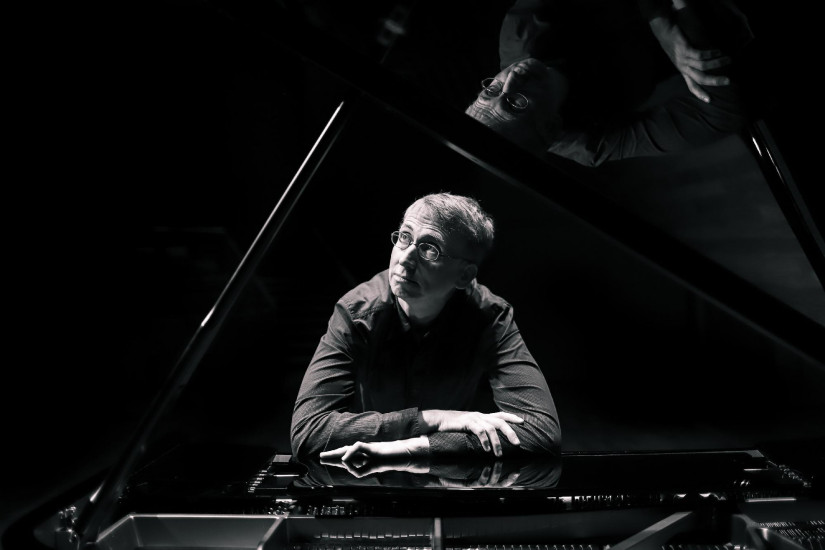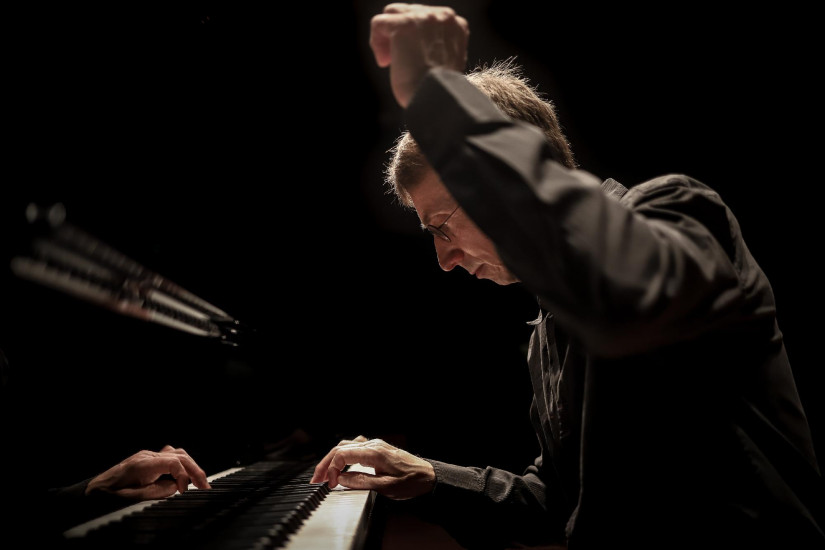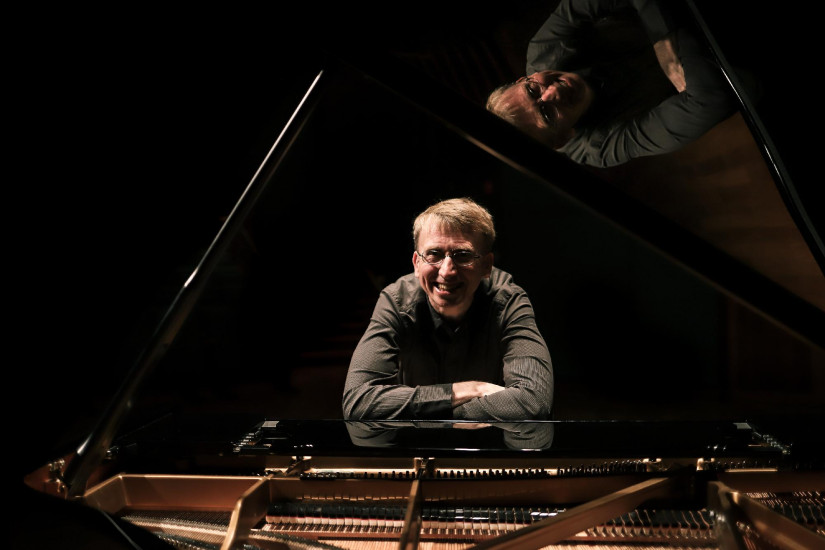Liszt and the glass pyramid in front of the Louvre
Pianist and Liszt researcher Kenneth Hamilton, author of the best-selling book After the Golden Age, gave a matinee concert in the Liszt Museum at the end of December. We talked about Liszt’s personality, his controversial critical appreciation, and Hamilton’s recent album, launched at the Liszt Museum in October and ranking fifth on the UK Classical Music Charts.
Molnár Fanni: How did you become so devoted to Liszt and his contemporaries?
Kenneth Hamilton: When I was about 14 or so, I didn’t know much at all about Liszt, just that he wrote Romantic music, some of which is extremely difficult. My teacher then told me to play Waldesrauschen. I not only loved the music itself, but also the physical feel of it. You can literally feel if the composer was a good pianist, because the piece fits the keyboard. Later, I also became interested in the literature around the Sonata in B minor and was personally captivated by this great piece – one of the finest in the piano repertoire. And of course, the pianistic ingenuity is fascinating too. In their teens, male pianists usually want to be the fastest and loudest, so the technical challenges of Liszt are appealing to them. But there is a lot more to his works. Liszt was one of the most inventive harmonists in Western art music. There are certain similarities with Wagner, of course, but not a complete overlap. His sheer productivity is also dazzling. There is so much music to investigate in his oeuvre. He wrote a massive number of pieces, and often prepared many versions of the same work, so even after so many years, I can say I don’t know everything yet. Last but not least, I entirely agree with what Wagner said: in Liszt’s output, even the things that are not important are interesting. He was such a great creative mind that he couldn’t write any works without at least one exciting idea. The contrast with other virtuoso composers such as Thalberg and Rubinstein is striking. They may have been great pianists, but as composers they are simply boring. Liszt has an original stamp and character: despite the great variety of his works, you can always tell if it’s his music or not – even just if it’s his arrangement.

MF: What is your personal image of Liszt, who is he for you?
KH: He’s a tortured soul, torn between sensuality, worldly success and deep religiousness. An astonishing and contradictory combination: on the one hand, he was extremely modest, on the other hand, he desperately wanted success and fame. Nevertheless, he always remained decent and genuinely benevolent, which is truly rare for famous artists. This essential humanity and internal struggle come out in his music, too. But I must add that you’ll never know anyone’s personality unless you’ve met them. Historical figures are lost in the past, however much we discover, or believe to know about them.
MF: In an essay, you wrote that Liszt is widely regarded as significant enough to celebrate, but that questions whether his music is good or not have never entirely gone away. Why is that so?
KH: The problem varies from country to country. In Britain, for example, the Victorian era considered him to be a somewhat immoral figure, and regarded Mendelssohn, by contrast, as the ideal artist and “family man”. They categorised Liszt as a circus performer, whose music is superficial, with the sole purpose of pleasing the public. This is inaccurate and grossly unfair, of course, but it fundamentally affected Liszt’s reception in the English-speaking world, and even after more than a century, the reputation of his music hasn’t recovered from it completely. Part of the problem is that Liszt became a great composer fairly late in life. His pieces from the 1830s and early 1840s show signs of genius, but not more, and he knew that very well himself. Chopin was born almost at the same time, but produced profound works much earlier, from the 1830s. Liszt simply took more time to find his own voice, but he had so much talent that he eventually produced the goods and confounded the critics. Another aspect of the problem is that he simply wrote too much. Chopin had a more consistent quality control, while Liszt produced many more works, inevitably including some weaker ones. Moreover, he made his learning process public. For example, he mentioned in a letter that his early songs were over-complex and over-sentimental, and needed revision. Yet these earlier versions had indeed been published. His many versions of the same piece eventually got closer and closer to his ideal form of the work. In Liszt, you can see the artist working, sometimes tentatively, towards his goal, and this doesn’t correspond to the naively Romantic ideal of the genius who receives inspiration as if from heaven and writes a perfect piece straightaway. In short, Liszt offered more material for his critics to criticise!

MF: If you could pick only one thing from what Liszt taught about his own works, something that we should observe still today, what would it be?
KH: His principle of phrasing as breathing: the concept of the flow of music as a living thing. Barlines should to some extent disappear, or at least not be obtrusively obvious. In a letter to an editor, Liszt once said that strictly metronomic performances are nonsensical, but it’s almost impossible to indicate the necessary rhythmic fluctuations in the score. If we sustain a sense of sweep, then the music will never become boring. Otherwise, the performance may be crystalline and beautiful, but can hardly speak to the heart. Liszt always encouraged this kind of rhetorical freedom.
MF: Besides recording them, you are constantly performing works by your teacher, Ronald Stevenson. Can you tell me a few examples of what you learnt from him that influenced your relationship to music on the deepest level?
KH: As a composer and performer, Ronald resembled Liszt in many respects, but we worked on relatively few Liszt pieces together. First of all, it was his endless creativity, the interplay of creativity as a performer and as a composer that made a great impact on me. It happened several times that I played one of his pieces, and for the next lesson, he changed his mind about some details, on one occasion even rewrote the ending completely. It was exactly the same with the Third Mephisto Waltz: after Liszt heard Marie Jaell play it, he realised how he should rework it. The second thing I learnt from Ronald is that the performer’s voice is almost as important in communicating the music as that of the composer. Liszt also often let his students alter the text of his pieces: if it worked better for them in another way, they could keep those minor changes. A public performance or the recording of music is always a collaborative act in an artistic sense, even if the composer is no longer living. In addition, you must be convinced about your musical decisions; if you don’t believe in them yourself, how can you hope to convince an audience?

MF: Can you briefly outline the spiritual and musical conception of your new Liszt album?
KH: Death and Transfiguration contains works that are related to topics that both Liszt and Wagner were obsessed with: love, death and transfiguration. I definitely wanted to include the Sonata in B minor, one of the greatest works of Liszt, and I also knew that I would end the recording with Liszt’s transcription of the Liebestod from Tristan. Liebestod is Liszt’s own title for that part of the opera, because Wagner originally referred to the closing scene as Isoldens Verklärung (transfiguration). Tristan und Isolde represents the quintessence of the love-death-transfiguration idea. Then I included other aspects of death and redemption with Pensées des Morts, and some other funeral pieces, and interspersed the middle-period music with some nostalgic and even macabre late works. I hope that the sequence of tracks offers a thought-provoking journey through all these aspects of Liszt’s creativity.
I like my albums to be Gesamtkunstwerke, to use the Wagnerian term. I wrote my own notes for the recording, while its cover is a painting by Max Nonnenbruch from a wonderful 19th-century Jugendstil collection that I came across just round the corner from our apartment in Wiesbaden, in the Hessisches Landesmuseum. The painting was partly intended as a religious piece of art, but at the same time, it’s probably no coincidence that it looks a lot like the transfiguration of Isolde. I don’t think anyone has used it as a CD cover before, and I was especially happy that I came across it, because connecting with sister arts was extremely important to Liszt. When you are making a recording, especially of pieces that have already been recorded hundreds of times, you must always ask yourself: why do I want to do this again? You must have some very persuasive artistic reason why you’re producing yet another record, otherwise it’s simply a vanity project. My solution is to have a concept behind my albums, so I can justify to myself ‒ and to others, if necessary ‒ why it was released in the first place. For example, I recorded the works in Harmonies poétiques and religieuses in a different order from that in which they were published, because I wanted to establish new connections between, and offer new perspectives on these pieces. Establishing new narratives by pointing out hidden inter-relationships can shed a fascinating light even on the most widely played works of music. It’s a bit like the pyramid in front of the Louvre in Paris: the artistic point is partly in the juxtaposition – that’s really the “new” thing here!
You can listen to three excerpts of Kenneth Hamilton's matinee concert (18/12/2021) on our YouTube channel.
Ronald Stevenson: Heroic Song for Hugh MacDiarmid
Liszt–Wagner: Isoldens Liebestod
Photos: Andrew Bi



